#International Finance Assignment Help
Explore tagged Tumblr posts
Text
Unlocking Success with International Finance Assignment Help

Celebrating one year of academic triumphs with FinanceAssignmentHelp.com and their exceptional international finance assignment help! As a student navigating the intricate world of international finance, I stumbled upon this academic haven when the challenges seemed insurmountable. Today, on my one-year anniversary with their services, I can't help but reflect on how they have been instrumental in shaping my academic journey.
How FinanceAssignmentHelp.com Helped Me:
International finance is a labyrinth of concepts, theories, and practical applications. Navigating through the complexities of exchange rates, capital flows, and risk management can be daunting for even the most dedicated students. That's where FinanceAssignmentHelp.com stepped in to illuminate the path to success.
This online platform offers unparalleled international finance assignment help, providing customized solutions tailored to individual needs. Whether it's understanding the intricacies of foreign exchange markets or deciphering the nuances of global investment strategies, their team of experts has consistently delivered top-notch assistance.
Why I Needed This Service:
The realm of international finance demands a comprehensive understanding of economic principles, market dynamics, and geopolitical factors. As a student with a fervent desire to excel, I found myself grappling with the intricate details of my international finance assignments. The need for clarity and expert guidance became evident, and that's when I turned to FinanceAssignmentHelp.com.
This service became my academic anchor, offering a lifeline when the waters of financial theories seemed too turbulent. Their team not only possesses profound knowledge of international finance but also has a knack for simplifying complex concepts, making them accessible to students at any level.
How to Find This Service:
Discovering FinanceAssignmentHelp.com was a game-changer for me, and it's a journey that began with a simple online search. The website's user-friendly interface and transparent approach stood out immediately. Navigating through their services, I found a dedicated section for international finance assignment help, complete with testimonials from satisfied students.
The process of finding this service is straightforward. A quick search using keywords like "international finance assignment help" led me straight to their website. The clear layout and detailed information about their services instilled confidence from the start. It's evident that they understand the unique challenges students face in international finance courses and are committed to providing targeted assistance.
Steps to Submitting Assignments and Receiving Solutions:
One of the aspects that sets FinanceAssignmentHelp.com apart is the seamless process they've established for submitting assignments and receiving solutions. The user-friendly interface ensures that even those new to online academic assistance can navigate the process effortlessly.
Place an Order:
Start by placing an order on their website, specifying the details of your international finance assignment. This includes the topic, deadline, and any specific requirements provided by your instructor.
Receive a Quote:
Shortly after submitting your order, you'll receive a quote outlining the cost of the service. The transparent pricing model ensures that you know exactly what to expect, with no hidden fees.
Make Payment:
Once you approve the quote, proceed to make the payment securely through their platform. Multiple payment options are available for convenience.
Work Commences:
The moment your payment is processed, their team of experts starts working on your international finance assignment. Regular updates and communication ensure that you're in the loop throughout the process.
Review and Feedback:
Before the final solution is delivered, you have the opportunity to review the work and provide feedback. This collaborative approach ensures that the solution aligns with your expectations.
Receive the Solution:
Once the assignment is finalized and reviewed, you'll receive the solution promptly. The comprehensive and well-explained answers serve as a valuable learning resource, enhancing your understanding of international finance concepts.
Conclusion:
As I celebrate one year of academic excellence with FinanceAssignmentHelp.com, I can confidently say that their international finance assignment help has been a cornerstone of my success. The journey from grappling with complex concepts to mastering the intricacies of international finance has been transformative, thanks to their unwavering support.
For any student navigating the challenging waters of international finance, I wholeheartedly recommend FinanceAssignmentHelp.com. Their commitment to academic excellence, transparent processes, and a team of knowledgeable experts make them the go-to destination for those seeking not just answers, but a profound understanding of international finance. Here's to many more years of partnership and continued success!
#International Finance Assignment Help#Help With International Finance Assignment#Online International Finance Assignment Help#International Finance Assignment Help Service
10 notes
·
View notes
Text

Seeking assignment assistance regarding international finance? 🌍📈 Geopolitical risks significantly affect how an international investment strategy is formed, market volatility, and asset allocation. Political turmoil, economic sanctions, as well as trade disputes strike quite a number of times at market manners and even at investor confidence. Visit at: https://www.finance-helpdesk.com/international-finance-assignment-homework-help.php
0 notes
Text
Working Capital Optimization: Essential Help for Finance Assignments
Introduction: What is Working Capital?
Working capital constitutes a crucial principle in the field of finance, signifying the short-term liquidity position of a firm. It is defined as the difference between an organization's current assets—encompassing cash, inventory, and accounts receivable—and its current liabilities, including accounts payable and short-term debt. In essence, it denotes the financial resources available to the company to facilitate its daily operational needs. Effective working capital management ensures that a company can meet its operational needs and financial obligations, while also channeling available resources to facilitate growth in the company.
Every student or learner involved in finance studies or assignments particularly those that relate to working capital, must understand the factors that explain the working capital. Why? Working capital belongs to the most critical indicators of financial performance since they directly reflect the financial result, availability of funds for operations, and risks involved. Effective management of work capital can enhance or develop efficiency in the business hence enhancing the performance by the firm. For students, to understand these dynamics students are usually tasked to solve various numerical questions to gain insights into the practical financial operations of businesses.
By opting for finance assignment help, students can get to know more about the perspective of working capital optimization and other advanced techniques in the field. This means that one can seek working capital study assistance from professional experts, especially in complex working capital problems as opposed to what is found in textbooks and theories. This involves an opportunity for students to gain a greater understanding of the subject, hence exposing them to applicable strategies for succeeding in their assignments.

Working Capital Optimization: Issue Diagnosis in Details
Working capital optimization can be defined as the means and methods that are used in the management of the short-term assets and liabilities of a business with the aim of ensuring the operations of the firm are done in the most efficient and profitable manner. This also means that there is a fine line to be drawn between the need for liquid assets to meet short-term obligations and bringing down capital expenses.
As regards finance students, it may appear that working capital optimization is quite simple and quite basic as a subject however in a real sense, it is quite an elaborate and complicated subject that can make or break a business. In this regard, we shall look at why working capital optimization is important, how the companies achieve these goals and real cases where companies have demonstrated a working capital optimization impact.
Why Optimize Working Capital?
It is quite evident that working capital management is of great importance for all businesses as it influences many key performance metrics:
Liquidity: Sufficient working capital ensures that the company can perform its short-term obligations in terms of paying off suppliers and employees.
Profitability: Proper working capital management will minimize the capital cost incurred, therefore increasing cash flows available for financing growth and innovation.
Operational Performance: Focused and disciplined working capital management enables businesses to operate more efficiently, decrease waste, and enhance stock control.
Risk Management: Working capital management in a business alleviates the operational risk exposure – Supply Chain risks, economic downturns, and other surprises that a business may experience.
For students, such a study helps to understand the rationale behind the varying impacts of the financial decisions made in a company on its various operations.
Ways on how Working Capital can be Improved
There are various strategies that can be recommended for companies that require improvement of the working capital. These strategies are aimed at ensuring that companies maintain adequate amounts of cash, increase cash inflows, and reduce cash outflows that are unnecessary in the first place.
Inventory Management
Inventory management is one of the key components of working capital management. A firm can enhance its liquidity profile by lowering the total stock holding of unsold products by minimizing excess stocks.
Methods such as JIT manufacturing systems, where products are sourced and produced only when needed. This approach helps companies save on stockholding expenditure and overproduction.
Example: Toyota was able to change the face of the auto industry with the implementation of the manufacturing system called Just In Time (JIT), giving the extra edge of efficiency coupled with a reduction in working capital requirements.
Accounts Receivable Management
Customers paying their bills within the set timeframe is very important. For further optimization of receivables, some credit control measures are often applied such as allowing discounts for early payments or limiting credit for customers with a history of poor payments.
Another approach known as factoring helps in supplementing working capital. This involves receivables sold to a third party thus providing cash flow in a shorter time frame.
Case Study: In its attempt to improve cash flow, General Electric in the year, 2009 commenced sales of parts of its receivables and created 2 billion in capital within a year leading the firm to focus more on growth and investment avenues.
Accounts Payable Management
The payable side is much more interesting. This is about optimizing for the longest period before making any payment ta the supplier without jeopardizing any existing credit or relationships. Cash flow may be enhanced if payment terms can be adjusted without any serious penalty for longer terms.
Purchasers may utilize the assisted financial program to make early payments to their suppliers through financial institutions, while the purchaser gets extended terms to preserve working capital.
Example: Walmart has entered into extended payment terms with its suppliers to preserve its working capital for longer terms.
Cash Management
Firms need to ensure that there is an optimal cash reserve committed to the working capital requirements and also minimize cash that is idle earning no returns.
Firms utilize sweeping mechanisms, in which the excess cash is transferred to an interest-bearing account thereby making returns out of excess cash and at the same time preserving liquidity.
Example: Microsoft is well known for its cash management practices. The world’s biggest computer software company has for many years managed to keep positive working capital instead of spending it on many things and maintains generous cash reserves for investments, buying back stock, and paying dividends.
The Role of Working Capital Management
The effect of working capital optimization is not limited to the enhancement of liquidity and cash flow alone. This is capable of reinventing the potential of a company for growth and competitiveness within the industry.
Better Financial Condition: Reduction in the amounts tied up in working capital positively impacts the company's operating cycle and the balance sheet. Improvement in some of the operational ratios such as current and quick ratios is also observed. This subsequently increases the creditworthiness and the cost of borrowing reduces.
Secure Superior Position: Efficient working capital allows organizations to respond to changes in the market more effectively. For instance, they will be able to take advantage of bulk buying discounts and invest in new opportunities more quickly than its competitors.
Recovery from Impacts: When the economy is going through difficult times, the likelihood of companies that strategically manage their working capital to manage disruptions. For instance, during the most recent period when the majority of the companies were in a cash liquidity crisis due to covid19 pandemic, companies that effectively managed cash flows survived.
Long-Term Development: Firms can free up cash from operational efficiency which then allows them to seek more growth opportunities like R&D, marketing, or expansion. Optimization of working capital, therefore, becomes the initial move towards the attainment of competitive advantage in due time.
Case Example: Apple Inc.
Apple Inc. is probably the most referenced case when it comes to the optimization of working capital. This has been made possible because of the peculiarities in the businesses of Apple-it is able to maintain working capital which is negative by collecting money from customers before it pays suppliers. This offers the company a huge liquidity edge and a key reason behind its financial performance.
Due to Apple’s excellent supply chain management processes and beneficial contractual payment agreements with suppliers, the company does not require additional working capital. Such a strategy releases massive amounts of cash flow, which Apple has invested in R&D, advertising, and acquisitions. As a result, Apple has grown and become a market leader.
Expert Finance Assignment Help for MBA Students
Our finance assignment assistance service is primarily directed toward MBA students who are having a tough time comprehending and practicing difficult areas such as working capital management. We offer detailed, individualized help to students in dealing with difficult assignments, case studies, and analysis.
As for complicated financial topics including working capital optimization, our company employs seasoned financial specialists with expertise in sophisticated techniques on liquidity, cash flow, and operational efficiency management. We break down these concepts into simple steps for students to facilitate their understanding of the theory and practical aspects of the problem. Our aim is not only to assist the learners in solving practical problems but help them learn how and when to utilize these techniques when they face real financial problems.
How Our Service Makes Complex Financing Problems Simple
We use a combination of visuals, like flowcharts and financial models in order to simplify difficulties in complicated financial problems. By demonstrating the relation between the problem to its financial theory, we make sure that students never miss any important aspect of the solution. We offer tailored solutions for case studies and give in-depth information on different working capital strategies used by top companies. This helps students understand how to use these strategies in their studies.
More Sophisticated Techniques and Wider Scope
We introduce students to new and improved methods that they can adopt in solving questions that go beyond the basics of financial management. Among those advanced techniques include; modeling of dynamic working capital, cash conversion optimization, and enhancing working capital with financial technologies.
Apart from working capital optimization, we also offer finance assignment assistance in a wide range of subjects including but not limited to:
Corporate Finance
Risk Management
Investment Analysis
Financial Statement Analysis
Capital Budgeting
Mergers & Acquisitions
Benefits for MBA Students:
Many students ask the question: “Why should I choose your service?” The explanation is that they not only get custom-made solutions that enable them to complete their tasks in due time but also enhance their grasp of contemporary financial principles. Our specialists always give new ideas to the students to enable them to apply in their coursework assignments for top grades.
Conclusion:
Working capital management is an important aspect of financial management. This influences liquidity and profitability as well as risk factors. Students studying finance must learn the concepts to have a deeper understanding of the practical issues of business functioning. By opting for our service and getting help with finance assignments, students can learn from experts and understand important topics better. We provide sample problems, case studies, textbooks, and research papers to help students complete their assignments confidently and clearly.
Textbooks and References for Students
For students who want to undertake deeper studies in the area of working capital optimization, the is a selection of relevant textbooks and some research papers that lay a good base.
One such textbook is “Financial Management: Theory and Practice” by Eugene F. Brigham & Michael C. Ehrhardt.– This particular book attempts to explain the fundamentals of why decisions are made financially with reasonable chapters on working capital management.
Corporate Finance Jonathan Berk and Peter DeMarz– A commonly recommended textbook, which considers some of the working capital management aspects among other principles of financial management.
#Financial analysis homework help#Help with finance projects#Personal finance assignment assistance#Financial management homework help#Online finance tutoring services#Finance case study assistance#International finance assignment help#Accounting and finance assignment help#Financial modeling assignment support
0 notes
Text
Currency Related Risks in International Finance: Comprehensive Assignment Support Notes
Measures such as the degree of currency fluctuation, commonly referred to as exchange rate risk plays a central role in international finance and risk management. It refers to the risk of loss of the value of investments by an individual, either an investor or a company, because of the changes in the foreign exchange rates. Currency risk is an important concept with which the students of international finance should become familiar as it impacts international business, investments, and financial reports. This article gives detailed information of how firms can be exposed to currency risk, how this risk affects their businesses, a list of current and past examples and case studies as well as where to get help with finance assignments.
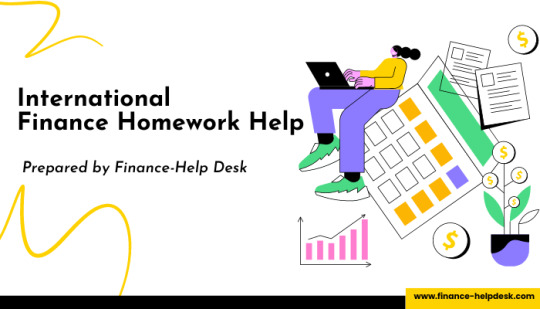
What is Currency Risk?
Currency risk refers to the situation where a business or an investor transacts in more than one currency. A fluctuation in exchange rate affects the business in terms of either profit or loss.
Apple Inc. has a big presence in the global market and conduct business transactions in numerous currencies. Through the Apple’s annual report, the effect of exchange rate fluctuations on its business can be easily identified. For instance, in 2022, due to the Russia-Ukraine war, Apple suffered up to an extent of about $2.8 billion.
Types of Currency Risk:
1. Transaction Risk: It is a situation where an individual or company received an order and getting the payment for the same. For instance, an American company that sells products to the European market will be adversely affected if the Euro declines relative to the Dollar between the time the invoice is issued and the time it is paid.
2. Translation Risk: Impacts those multinational firms that have their financial statements prepared in a foreign currency and are required to convert into their home currency. Changes in exchange rates can affect the reported earnings and the value of assets on the balance sheet.
3. Economic Risk: This simply relates to the long term effect of such exchange rate changes on the particular company’s worth and market share.
How to effectively Managing Currency Risk?
Effectively managing currency risk involves various strategies and financial instruments:
1. Hedging: Hedging is the most widely used approach used to manage currency risk. Hedging is the utilization of financial instruments like forward contracts, futures, options and swaps to guarantee that exchange rates are fixed so as to counter balance undesirable fluctuation.
2. Natural Hedging: Refers to the organization of operations in a way that provides for the netting of currency exposure. For instance, a company may decide to offset the operating revenue in one foreign currency with an equivalent operating expense in the same currency to eliminate the net exposure.
3. Diversification: Investing in different geographic areas and having exposure to different currencies to hedge the effect of any currency’s fluctuation.
4. Currency Clauses: Incorporating clauses that trigger changes in prices charged in contracts to cover for adverse fluctuation in the exchange rates.
Let us assume an American firm has anticipated receivables of €1 million from a European buyer, within the next three months. One way to manage exchange risk and particularly the risk of the Euro depreciating against the Dollar is use of forward foreign exchange contracts whereby the company will forward sell €1 million at the current exchange rate thus removing this kind of uncertainty entirely.
How Technology Plays a Role in Managing Currency Risk?
The technological developments have changed the worlds of currency risk in the context of other businesses. Advanced tools including software and algorithms are capable of reading the market and the future behavior of the currency as well as independently calculate the hedge options. Fintech companies provide platforms that supply such information in real time with facts and the assessment of risks and possible transactions for better currency risk management.
Impact of Geopolitical Events in Currency
Knowing the geopolitical exposures are important because when used correctly they can help international investors and businesses to manage the exchange risks effectively. Factors such as unstable Governments, economic sanctions and trade wars can result in fluctuations of currency. For instance, trade tensions between the US and China have resulted in fluctuations in the Chinese Yuan (CNY), posing a risk to those companies that invest in China.
Get expert service for international finance homework support
Understanding currency-related risks is crucial for anyone involved in international finance, as these risks significantly impact businesses, investors, and economies worldwide. For students learning about international finance and risk management, it is essential to grasp these risks and develop strategies to mitigate them. This involves using hedging techniques, staying updated on geopolitical events, and leveraging advanced technology to manage currency risks effectively.
To further assist with assignments and coursework in international finance, students can refer to their textbooks and the resources mentioned earlier. For additional support, students in the USA and UK can access the International Finance Assignment Help service. This service offers personalized assistance to help with coursework and assignments, ensuring that students understand complex concepts and succeed academically.
Common Exam and Assignment Questions
Students studying international finance often face tasks like analyzing the impact of exchange rate fluctuations on a company’s financial performance, understanding currency risk, and designing hedging strategies using financial instruments like forward contracts, options, and swaps. Assignments may include solving real-world case studies, such as those involving Brexit or US-China trade tensions, and assessing a company's economic exposure to currency risk. Understanding the effect of currency fluctuations on multinational companies' financial statements is also a common exam question. For personalized assistance, the International Finance Homework Help provides expert guidance tailored to students' academic needs.
How the Service Can Help Tackle Such Tasks
The International Finance Assignment Help offers detailed explanations of complex concepts, uses real-world examples and case studies, and provides customized solutions for specific assignments. It guides students to helpful study resources like textbooks and articles and offers revision support to improve drafts for clarity and accuracy. This comprehensive support helps students understand and excel in their international finance tasks.
Helpful Resources and Textbooks
International Financial Management by Jeff Madura: This textbook provides comprehensive coverage of international finance, including currency risk management, hedging strategies, and real-world examples.
"Multinational Business Finance" by David K. Eiteman, Arthur I. Stonehill, and Michael H. Moffett: A detailed guide to managing financial operations in a global environment, with a focus on currency risk and exposure.
Financial news websites like Bloomberg and Reuters that offer real-time data, analysis, and news on global currency markets.
Finance-helpdesk.com for content on basic finance concepts, computational questions and case studies.
0 notes
Text
Empower yourself for success with Finance Assignment Help. Our expert guidance and tailored solutions ensure students excel in their finance coursework. Gain confidence, achieve top grades, and unlock your academic potential with our assistance.
0 notes
Text
Navigating the Complex World of Finance: An Interview with an International Finance Assignment Help Expert

As the global economy continues to evolve, the field of international finance becomes increasingly intricate and challenging for students. To shed light on this complex subject and provide valuable insights, we sat down for an enlightening conversation with an International Finance Assignment Help expert. Our goal was to unravel the mysteries of international finance, understand the challenges students face, and explore the importance of seeking assistance when tackling assignments in this dynamic field.
Student (S): Thank you for joining us today. To kick things off, could you share a bit about your background and expertise in international finance?
International Finance Assignment Help Expert (E): Certainly! I have been immersed in the world of finance for over a decade, specializing in international finance. My journey began with a passion for understanding how financial markets operate on a global scale. I pursued advanced degrees in finance and have since been dedicated to helping students navigate the complexities of international finance through assignment assistance and guidance.
S: That's impressive. International finance can be quite overwhelming for students. Can you highlight some common challenges they face when dealing with assignments in this field?
E: Absolutely. One of the primary challenges students encounter is the extensive range of topics within international finance. From exchange rates and international investment to risk management and financial markets, the sheer breadth of the subject can be daunting. Additionally, the dynamic nature of global financial markets means that students must stay updated on the latest trends and geopolitical events, adding another layer of complexity to their assignments.
S: Given these challenges, how can seeking International Finance Assignment Help benefit students?
E: Seeking assistance can provide students with several advantages. Firstly, it offers a personalized approach to learning. Many students find that one-on-one guidance helps them grasp intricate concepts more effectively. Moreover, assignment help services often employ experts who have practical experience in the field, offering real-world insights that go beyond textbook knowledge. This can be invaluable in understanding the practical applications of international finance theories.
S: That makes sense. When students approach you for help, what are some of the common areas they struggle with the most?
E: A recurring theme is the application of theoretical concepts to real-world scenarios. Students often find it challenging to bridge the gap between what they learn in class and how it translates to practical situations. Additionally, understanding the intricacies of currency markets, managing exchange rate risk, and comprehending the impact of global economic events on financial decisions are areas where many students seek clarification.
S: How do you approach guiding students through these challenging areas?
E: I believe in a hands-on approach. Rather than just providing answers, I strive to guide students through the thought processes and methodologies involved in solving problems. This not only helps them complete their assignments but also enhances their analytical and problem-solving skills, which are crucial in the field of international finance. It's about fostering a deeper understanding of the subject matter.
S: That sounds like a comprehensive approach. Speaking of real-world applications, can you share any examples of how international finance concepts play a role in today's global business landscape?
E: Certainly. Take, for instance, multinational corporations. They operate in multiple countries, dealing with various currencies and facing diverse financial challenges. Understanding how to manage exchange rate risk and make informed financial decisions in such a complex environment is crucial. Additionally, global economic events, like trade tensions or geopolitical shifts, can have a profound impact on financial markets, influencing investment decisions and risk management strategies.
S: It's fascinating how these concepts directly influence business operations. For students aspiring to enter the field of international finance, what advice would you offer?
E: My advice would be to embrace curiosity and stay curious. International finance is a dynamic field that requires a continuous willingness to learn and adapt. Stay updated on global economic trends, explore case studies, and seek practical experiences through internships or projects. And, of course, don't hesitate to seek help when needed. The field is vast, and collaboration with experts can provide valuable perspectives that enhance your understanding.
S: Wise words. Finally, how do you see the future of international finance education evolving, and what role will assignment help services play in this evolution?
E: The future holds exciting possibilities for international finance education. As the global economy becomes more interconnected, the demand for professionals with expertise in international finance will likely increase. In response, educational institutions may further integrate practical applications and real-world scenarios into their curriculum. Assignment help services will continue to play a crucial role by providing students with the support they need to excel in this evolving landscape, ensuring that they are well-prepared for the challenges of the global financial arena.
In conclusion, our conversation with the International Finance Assignment Help expert has shed light on the intricate world of international finance. As students grapple with complex assignments, seeking assistance from experienced professionals proves to be a valuable resource. By fostering a deeper understanding of theoretical concepts, bridging the gap between theory and practice, and providing real-world insights, these experts contribute significantly to the success of aspiring finance professionals in an ever-changing global economy.
#international finance Assignment Help#Help With international finance Assignment#Online international finance Assignment Help#international finance assignment help service
0 notes
Text
GAAP vs IFRS

Decoding US Accounting Rules: GAAP vs IFRS | Expert Insights in 2024
Navigate the GAAP vs IFRS debate in US Accounting effortlessly. Gain expert insights, make sense of regulations. Your guide to financial clarity.
The evolving landscape of accounting standards unfolds a nuanced debate between the Generally Accepted Accounting Principles and the International Financial Reporting Standards. These two frameworks, while sharing a common goal of transparent financial reporting, diverge in their approaches, giving rise to a multifaceted discourse with far-reaching implications for the financial world.

1. Introduction
The evolution of accounting standards has witnessed the crystallization of two dominant frameworks – General Accounting Accepted Principles and International Financial Reporting Standards. In the labyrinth of financial reporting, companies grapple with choosing between these standards, each with its unique history, principles, and global relevance. The debate surrounding GAAP vs IFRS is not a mere academic exercise but a pivotal consideration with implications for investment decisions, legal compliance, and the global financial landscape.
1.1. Evolution of Accounting Standards
The journey of accounting standards traces back to the aftermath of the 1929 stock market crash when the need for standardized, transparent financial reporting became glaringly apparent. What emerged were the General Accounting Accepted Principles, designed to restore investor confidence by providing a reliable framework for financial statements. Over time, GAAP has become deeply embedded in the U.S. financial system, shaping the way companies communicate their financial health.
On the global stage, the International Financial Reporting Standards evolved as a response to the growing interconnectedness of economies. The International Accounting Standards Board (IASB) took the reins in developing IFRS, aiming for a standardized global language of financial reporting. This set the stage for a two-pronged approach to financial reporting standards – General Accounting Accepted Principles dominating in the U.S. and International Financial Reporting Standards gaining traction internationally.
1.2. The Crucial Role of GAAP and IFRS
GAAP stands as the bedrock of accounting standards in the United States, overseen by the Financial Accounting Standards Board (FASB). Its principles, rooted in historical cost, revenue recognition, and matching, provide stability and a familiar structure for U.S. businesses. On the other hand, IFRS, under the stewardship of the IASB, operates as a global player, emphasizing fair value, substance over form, and materiality.
The significance of General Accounting Accepted Principles lies in its historical context and its alignment with the unique needs of the U.S. business environment. Its principles have served as a guiding light for American companies, offering a consistent framework for financial reporting. International Financial Reporting Standards, with its global perspective, caters to the interconnectedness of today’s businesses, providing a common language for multinational corporations.
1.3. Navigating the GAAP vs IFRS Dilemma
The choice between General Accounting Accepted Principles and International Financial Reporting Standards is not a one-size-fits-all decision. Companies grapple with a complex decision-making process, considering factors such as their geographical reach, industry nuances, and investor preferences. This debate is not isolated to boardrooms; it resonates in financial markets, legal proceedings, and regulatory landscapes, shaping the very fabric of financial reporting practices.
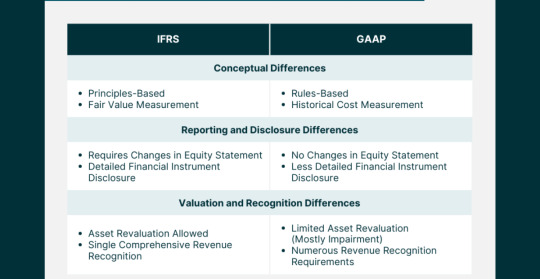
2. Understanding GAAP
2.1. The Foundation of GAAP
a. Historical Roots and Evolution
GAAP’s roots delve deep into the need for a standardized accounting framework post the 1929 stock market crash. FASB emerged as a response to the chaos that ensued, charged with the responsibility of establishing and improving financial accounting and reporting standards. The journey of GAAP has been one of continuous evolution, adapting to the changing business landscape and regulatory requirements.
b. FASB’s Ongoing Influence
The Financial Accounting Standards Board (FASB) stands as the guardian of GAAP, playing a pivotal role in setting and refining accounting standards. FASB’s mission goes beyond rule-making; it seeks to improve financial reporting, providing transparency and relevance in financial statements. The ongoing influence of FASB ensures that GAAP remains adaptive and responsive to the dynamic nature of business transactions.
2.2. Core Principles Anchoring GAAP
a. Embracing the Historical Cost Principle
One of the cornerstones of GAAP is the historical cost principle, dictating that assets should be recorded at their original cost. This principle provides stability and reliability in financial statements, allowing users to assess the financial health of a company based on the actual cost of its assets at the time of acquisition. While critics argue that this approach may not reflect current market values, proponents emphasize the prudence and consistency it offers.
b. Revenue Recognition as a Cornerstone
GAAP’s approach to revenue recognition centers on the realization and earned criteria. Revenue is recognized when it is realized or realizable and earned. This conservative approach ensures that revenue is not prematurely recognized, aligning with the matching principle. While this method may defer recognizing revenue until later stages in the sales cycle, it safeguards against potential overstatement and presents a cautious picture to investors.
c. The Significance of the Matching Principle
The matching principle is a guiding force in GAAP, emphasizing the alignment of expenses with the revenue they generate. This principle ensures that the costs associated with generating revenue are recognized in the same period as the revenue itself, presenting a more accurate portrayal of a company’s profitability. While adhering to the matching principle might result in lower reported profits during high-revenue periods, it provides a more realistic long-term view.
2.3. Scrutinizing Criticisms and Recognizing Limitations
a. Rigidity vs. Stability
One common criticism leveled against GAAP is its perceived rigidity, particularly regarding the historical cost principle. Critics argue that this approach may not capture the true economic value of assets, especially in industries with rapidly changing market conditions. However, proponents assert that this rigidity provides stability and consistency, allowing for easier comparison across periods and industries.
b. The Balancing Act of Revenue Recognition
The conservative approach to revenue recognition in GAAP has faced scrutiny for potentially understating a company’s immediate financial performance. Critics argue that this caution may not be reflective of a company’s true economic position, especially in industries where revenue realization is instantaneous. However, the balancing act lies in mitigating the risk of premature revenue recognition, ensuring financial statements maintain integrity and accuracy.
c. Challenges in Adhering to the Matching Principle
While the matching principle aligns expenses with revenue, critics contend that it introduces complexities in determining the direct association between costs and specific revenue streams. This challenge becomes more pronounced in industries with diverse revenue sources. Despite these challenges, adhering to the matching principle remains integral in presenting a holistic view of a company’s financial health, helping investors make informed decisions.
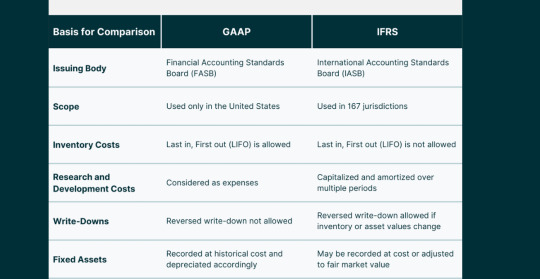
3. Embracing IFRS
3.1. IFRS: A Global Framework
a. The Rise of International Financial Reporting Standards
The emergence of IFRS marks a significant shift towards a globalized approach to financial reporting. As businesses expanded internationally, the need for a common accounting language became evident. IFRS, under the stewardship of the International Accounting Standards Board (IASB), rose to prominence as a framework that transcends borders, providing a standardized set of principles for companies operating on the world stage.
b. IASB’s Pivotal Role in Shaping IFRS
The International Accounting Standards Board (IASB) shoulders the responsibility of developing and maintaining IFRS. Unlike GAAP, IFRS operates under a principles-based approach, focusing on broad principles rather than detailed rules. This flexibility allows for easier adaptation to diverse business environments, making IFRS an attractive choice for multinational corporations seeking a harmonized approach to financial reporting.
3.2. Unpacking Core Principles of IFRS
a. Fair Value Measurement: A Paradigm Shift
One of the fundamental differences between GAAP and IFRS lies in the approach to asset valuation. While GAAP predominantly adheres to the historical cost principle, IFRS leans towards fair value measurement. Fair value reflects the current market value of assets, providing a more dynamic and responsive perspective. Critics argue that fair value introduces volatility, but proponents emphasize its relevance in capturing real-time economic conditions.
b. Substance Over Form: Emphasizing Economic Reality
In IFRS, the substance of transactions takes precedence over their legal form. This principle ensures that financial statements reflect the economic reality of transactions, promoting transparency and accuracy. While this approach aligns with the overarching goal of providing relevant information to users, it requires careful judgment and interpretation, potentially introducing subjectivity in financial reporting.
c. Materiality’s Role in Flexibility
IFRS introduces greater flexibility in materiality judgments compared to GAAP. Materiality refers to the threshold at which information becomes relevant to users. The more flexible stance in IFRS allows entities to exercise judgment in determining what information is material, considering both quantitative and qualitative factors. This flexibility, while enhancing the adaptability of IFRS, also raises concerns about potential inconsistencies in financial reporting.
3.3. Weighing Advantages and Drawbacks
a. IFRS Flexibility: A Double-Edged Sword
The flexibility embedded in IFRS is both its strength and weakness. Proponents argue that this adaptability makes IFRS suitable for diverse business environments, allowing for easier integration with various industries and legal systems. However, critics contend that this very flexibility can lead to inconsistencies and a lack of comparability, challenging the reliability of financial statements for investors and stakeholders.
b. Global Appeal vs. Application Challenges
The global nature of IFRS makes it an attractive choice for multinational companies aiming for consistency in financial reporting across borders. The common language of IFRS facilitates international transactions and fosters a seamless global financial landscape. However, the application of IFRS can pose challenges in jurisdictions with varying legal and regulatory frameworks, potentially leading to complexities in implementation and interpretation.

4. Key Differences Between GAAP and IFRS
4.1. Delving into Variances
a. Revenue Recognition: The GAAP-IFRS Divergence
One of the pivotal differences between GAAP and IFRS lies in the recognition of revenue. While both frameworks aim to depict the economic reality of transactions, their approaches diverge in certain key aspects. GAAP tends to be more prescriptive, providing specific guidelines for various industries, whereas IFRS adopts a broader principles-based approach, allowing entities more room for interpretation.
b. Inventory Valuation: Differing Approaches
The treatment of inventory valuation varies significantly between GAAP and IFRS. GAAP typically follows a specific set of rules for valuing inventory, such as the Last In, First Out (LIFO) or First In, First Out (FIFO) methods. In contrast, IFRS permits the use of various methods, including FIFO and weighted average, offering companies more flexibility in choosing an approach that aligns with their specific business dynamics
c. Consolidation Methods: Navigating Complexity
Consolidation methods, particularly in the context of subsidiaries and investments, showcase differences between GAAP and IFRS. GAAP often employs a more rule-based approach, specifying conditions for consolidation. In contrast, IFRS focuses on a principles-based approach, considering the substance of relationships rather than relying on rigid criteria. This variance introduces nuances in financial reporting, influencing how companies present their financial position and performance.
4.2. The Impact on Financial Statements
a. Shaping Investor Perception
The differences in revenue recognition, inventory valuation, and consolidation methods contribute to variations in financial statements produced under GAAP and IFRS. Investors, as key stakeholders, must navigate these differences to gain an accurate understanding of a company’s financial health. The choice between GAAP and IFRS significantly shapes investor perception, influencing investment decisions and risk assessments.
b. Decision-Making Dynamics
Companies, in choosing between GAAP and IFRS, must consider the implications on decision-making dynamics. The framework adopted affects how financial information is presented, potentially influencing strategic decisions, mergers and acquisitions, and capital-raising activities. Understanding the impact of these frameworks on decision-making is crucial for entities operating in dynamic and competitive business environments.
4.3. Global Adoption Trends: A Comparative Analysis
The adoption trends of GAAP and IFRS provide insights into the global dynamics of financial reporting standards. While GAAP maintains dominance within the United States, IFRS has gained traction in numerous jurisdictions worldwide. Understanding the factors influencing these trends, such as regulatory requirements, investor preferences, and global market integration, sheds light on the evolving landscape of accounting standards.
“Accounting isn’t just about profits and losses; it’s about sculpting the financial soul of a company.” Michael Johnson

5. The Evolution of Accounting Standards
5.1. GAAP’s Historical Odyssey
a. Post-1929: A Catalyst for Change
The stock market crash of 1929 served as a catalyst for rethinking the approach to financial reporting. The chaos that ensued prompted the establishment of standardized accounting principles, laying the foundation for what would later become GAAP. The primary goal was to restore investor confidence by providing a reliable framework for financial statements, reducing uncertainty and fostering stability in financial markets.
b. Amendments and Updates: Shaping GAAP’s Trajectory
GAAP’s journey has not been static; it has evolved through amendments and updates to address emerging challenges and align with changing business dynamics. The Financial Accounting Standards Board (FASB) plays a pivotal role in shaping GAAP, ensuring that it remains relevant, transparent, and responsive to the needs of companies and investors. The ongoing commitment to refinement reflects a dedication to maintaining the integrity of financial reporting.
5.2. Internationalization Efforts
a. Pioneering Attempts at Global Standardization
As globalization gained momentum, so did the recognition of the need for global accounting standards. Efforts were made to align U.S. GAAP with international standards, but achieving a universal standard proved challenging. The push for global standardization gained traction with the rise of IFRS, offering a framework that transcends national boundaries and facilitates consistency in financial reporting for multinational corporations.
b. The Challenge of Aligning U.S. Standards Globally
While the concept of global accounting standards gained support, aligning U.S. GAAP with international standards presented formidable challenges. The unique legal, regulatory, and cultural landscape in the United States posed hurdles to seamless integration. Despite these challenges, the pursuit of convergence and harmonization continued, reflecting the recognition of the interconnectedness of global economies.
5.3. Convergence Initiatives
a. The Ongoing Pursuit of Harmonization
Convergence initiatives aimed at harmonizing GAAP and IFRS gained prominence in the early 21st century. The objective was to reduce disparities between the two frameworks, fostering a more standardized global approach to financial reporting. While full convergence remained elusive, progress was made in aligning specific standards, reflecting a commitment to minimizing inconsistencies and facilitating ease of comparison for investors and stakeholders.
b. Prospects and Hurdles in a Unified Global Standard
The prospects of a unified global accounting standard remain a tantalizing goal, promising enhanced comparability and consistency in financial reporting. However, hurdles such as divergent national interests, legal complexities, and varying levels of standard-setting infrastructure continue to challenge the realization of this vision. Navigating these obstacles requires ongoing collaboration and a commitment to the overarching goal of global financial transparency.

6. Regulatory Bodies Influencing GAAP
6.1. FASB’s Pivotal Role
a. GAAP’s Guardian: The FASB Mandate
The Financial Accounting Standards Board (FASB) stands as the guardian of GAAP, wielding influence over the development and refinement of accounting standards. FASB’s mandate goes beyond rule-making; it encompasses a commitment to improving financial reporting, ensuring that standards are not only relevant but also responsive to the evolving needs of businesses and investors.
b. FASB’s Mission in Financial Reporting Improvement
FASB’s mission revolves around the improvement of financial reporting through the development of high-quality accounting standards. The board operates under a due process system, seeking input from various stakeholders, including investors, auditors, and preparers of financial statements. This collaborative approach ensures that GAAP remains a robust and adaptive framework that reflects the intricacies of modern business transactions.
6.2. SEC’s Watchful Eye
a. SEC’s Authority in Recognizing GAAP Standards
The Securities and Exchange Commission (SEC) plays a crucial role in the oversight of financial reporting in the United States. While the FASB sets accounting standards, the SEC has the authority to recognize and prescribe the principles used in the preparation of financial statements for publicly traded companies. This dual-layered system ensures a balance between industry expertise and regulatory oversight in shaping GAAP.
b. SEC’s Contributions to Financial Transparency
The SEC’s contributions to financial transparency extend beyond its recognition of GAAP standards. The commission actively engages in rule-making and enforcement to ensure that companies adhere to accounting principles and provide accurate and timely financial information to investors. The synergy between the SEC and FASB reinforces the integrity of financial reporting in the U.S. capital markets.
6.3. AICPA’s Industry Impact
a. AICPA: Nurturing Professional Standards
The American Institute of Certified Public Accountants (AICPA) plays a vital role in shaping professional standards within the accounting industry. While not directly involved in setting GAAP, the AICPA contributes to the development of ethical and professional standards that guide the conduct of accountants. This commitment to excellence enhances the credibility of financial reporting, reinforcing the trust that stakeholders place in GAAP.
b. Industry-Wide Compliance through AICPA Guidance
The AICPA’s influence extends beyond standards development to encompass industry-wide compliance. The organization provides guidance on best practices, ethical considerations, and emerging issues within the accounting profession. This guidance ensures a cohesive and ethical approach to financial reporting, aligning with the principles embedded in GAAP and contributing to the overall reliability of financial statements.

7. International Bodies Shaping IFRS
7.1. IASB’s Global Mandate
a. IASB’s Significance in IFRS Development
The International Accounting Standards Board (IASB) holds a central role in the development and maintenance of IFRS. Unlike the FASB’s role in the U.S., the IASB operates on a global scale, aiming to set accounting standards that are applicable and relevant to entities worldwide. The IASB’s commitment to a principles-based approach reflects its recognition of the diverse needs of global businesses.
b. A Global Perspective in Standard Setting
The IASB’s global perspective is intrinsic to its standard-setting process. The board considers input from various regions, industries, and stakeholders, ensuring that IFRS reflects the nuances of international business. The principles-based approach allows for adaptability, catering to the diverse legal, economic, and cultural landscapes in which entities operate globally.
7.2. IFRIC’s Interpretative Role
a. Navigating Grey Areas: IFRIC’s Guidance
The International Financial Reporting Interpretations Committee (IFRIC) plays a crucial role in navigating interpretative challenges within IFRS. Given the principles-based nature of IFRS, grey areas may arise, requiring clarification and guidance. IFRIC addresses these challenges by providing interpretations and guidance, ensuring consistent application of IFRS standards across diverse industries and jurisdictions.
b. Consistent Application of IFRS Standards
Consistency in the application of IFRS standards is paramount to ensuring comparability and reliability in financial reporting. IFRIC’s interpretative role contributes to this objective by offering guidance on ambiguous or complex issues. This commitment to clarity and consistency aligns with the overarching goal of IFRS – to provide a common language for financial reporting that transcends geographical and industry-specific boundaries.
7.3. Monitoring Board’s Oversight
a. Ensuring Independence in Standard Setting
The Monitoring Board plays a crucial oversight role in ensuring the independence and effectiveness of the IFRS Foundation, which houses the IASB. Independence is a cornerstone of credible standard-setting, and the Monitoring Board’s role is to safeguard the integrity of the standard-setting process. This commitment to independence reinforces the trust that global stakeholders place in IFRS as a reliable and unbiased framework.
b. The Role of the Monitoring Board in IFRS Integrity
The Monitoring Board’s vigilance extends beyond independence to the broader integrity of the IFRS framework. By overseeing the activities of the IFRS Foundation and IASB, the Monitoring Board contributes to the credibility of IFRS as a global accounting standard. This oversight ensures that IFRS continues to meet the evolving needs of global financial markets and remains a trusted framework for transparent financial reporting.

8. Impact on Financial Reporting
8.1. Side-by-Side Comparison
a. Financial Statement Variances: GAAP vs IFRS
A side-by-side comparison of financial statements prepared under GAAP and IFRS reveals variances arising from differences in principles, approaches, and interpretations. These variances extend to revenue recognition, asset valuation, and consolidation methods, influencing the reported financial position and performance of entities. Investors and analysts must navigate these differences to glean accurate insights into a company’s financial health.
b. Interpretation Challenges for Investors
Investors face interpretation challenges when analyzing financial statements prepared under different frameworks. Understanding the nuances of GAAP and IFRS differences is crucial for making informed investment decisions. The ability to discern how specific accounting choices impact financial metrics empowers investors to evaluate risks, assess potential returns, and navigate the complexities of the global investment landscape.
8.2. Revenue Recognition Dynamics
a. The Nuances of Revenue Recognition
The nuances of revenue recognition under GAAP and IFRS reflect the underlying philosophies of each framework. GAAP, with its prescriptive guidelines, provides specific criteria for recognizing revenue in various industries. In contrast, IFRS adopts a broader approach, emphasizing the substance of transactions over rigid rules. Navigating these nuances requires a deep understanding of industry dynamics and the specific requirements of each framework.
b. Implications for Investor Decision-Making
The implications of revenue recognition dynamics extend to investor decision-making. Differences in when and how revenue is recognized can influence perceptions of a company’s immediate financial performance. Investors must factor in these nuances to make informed decisions, considering the impact on key financial metrics such as earnings per share, profit margins, and return on investment.
8.3. Asset Valuation Approaches
a. Valuation Philosophies: Fair Value vs. Historical Cost
The variance in asset valuation philosophies between GAAP and IFRS introduces complexities in financial reporting. GAAP’s adherence to historical cost provides stability and consistency, albeit potentially understating the current market value of assets. In contrast, IFRS’s emphasis on fair value introduces a more dynamic and responsive approach to asset valuation. Companies must navigate the trade-offs between stability and accuracy in presenting their financial position.
b. Balancing Accuracy and Stability in Asset Reporting
Balancing accuracy and stability in asset reporting requires careful consideration of the trade-offs between fair value and historical cost. Companies must weigh the benefits of presenting current market values against the potential volatility introduced by fair value measurements. Striking the right balance ensures that financial statements accurately reflect the economic reality of a company’s assets while providing stakeholders with a stable and reliable foundation for decision-making.

9. Challenges in Adoption
9.1. Corporate Resistance Factors
a. Unpacking Corporate Hesitations
The decision to adopt new accounting standards, whether transitioning from GAAP to IFRS or vice versa, is met with corporate hesitations. Companies fear the potential disruptions, costs, and uncertainties associated with the transition. Understanding these resistance factors is essential for regulatory bodies, standard-setters, and industry stakeholders to develop strategies that facilitate smoother adoptions and ensure widespread compliance.
b. Overcoming Corporate Resistance Challenges
Overcoming corporate resistance challenges requires a multi-faceted approach. Clear communication on the benefits of the new standards, comprehensive training programs, and support mechanisms can alleviate concerns. Regulators and standard-setters must collaborate with industry representatives to address specific challenges faced by different sectors, fostering a cooperative environment conducive to successful adoptions.
9.2. Implementation Costs
a. Financial and Operational Impacts
The implementation of new accounting standards incurs financial and operational impacts for companies. Costs associated with staff training, system upgrades, and adjustments to internal processes contribute to the overall financial burden. Companies must carefully assess these costs and develop comprehensive implementation plans to mitigate disruptions and ensure a seamless transition to the new standards.
b. Strategies for Mitigating Implementation Costs
Strategies for mitigating implementation costs involve proactive planning, phased adoption approaches, and leveraging technology. Companies can benefit from engaging with industry peers that have successfully navigated similar transitions, learning from best practices and challenges. Collaboration between standard-setters, regulatory bodies, and industry associations plays a crucial role in developing strategies that balance the need for improved standards with the practicalities of implementation.
9.3. Training and Skill Gaps
a. The Need for Specialized Training
The adoption of new accounting standards introduces the need for specialized training to ensure that professionals possess the skills required for compliance. Training programs must address the nuances of the new standards, focusing on changes in accounting principles, reporting requirements, and the application of new methodologies. Bridging skill gaps is crucial for maintaining the integrity and accuracy of financial reporting.
b. Collaborative Approaches to Skill Development
Collaborative approaches to skill development involve partnerships between educational institutions, professional organizations, and industry players. The goal is to create comprehensive training programs that equip professionals with the knowledge and skills necessary for successful compliance. Standard-setters and regulators can play a pivotal role in promoting and endorsing such collaborative initiatives, fostering a culture of continuous learning within the accounting profession.

10. Legal Implications for Corporations
10.1. Legal Challenges in GAAP Compliance
a. Litigation Risks in GAAP Adherence
The legal challenges associated with GAAP compliance include litigation risks arising from alleged non-compliance. Companies adhering to GAAP must navigate the complexities of the legal landscape, ensuring that their financial statements withstand scrutiny. Implementing robust internal controls, engaging in transparent communication, and staying abreast of legal developments are essential strategies for mitigating litigation risks.
b. Strategies for Legal Compliance in GAAP
Strategies for legal compliance in GAAP involve proactive measures to minimize litigation risks. This includes fostering a culture of compliance within the organization, conducting regular internal audits, and seeking legal counsel to ensure alignment with evolving regulations. Companies that prioritize legal compliance contribute to the overall stability and trustworthiness of the financial reporting ecosystem.
10.2. Legal Battles in IFRS Adoption
a. Navigating Legal Challenges in IFRS Transition
The transition to IFRS introduces legal battles that companies must navigate effectively. Disputes may arise over interpretations of IFRS standards, potentially leading to litigation. Companies must engage in comprehensive risk assessments, understanding the legal implications of IFRS adoption, and implementing measures to mitigate potential legal challenges.
b. Legal Safeguards for Companies Adopting IFRS
Legal safeguards for companies adopting IFRS involve proactive steps to minimize legal risks. This includes engaging legal experts in the transition process, conducting impact assessments, and implementing robust governance structures. Companies that prioritize legal safeguards position themselves to navigate the complexities of IFRS adoption with resilience and integrity.
10.3. Risk Mitigation Strategies
a. Legal Safeguards: Mitigating Risks in Regulatory Compliance
Legal safeguards play a pivotal role in mitigating risks associated with regulatory compliance. Companies must implement effective risk management strategies, including regular legal audits, compliance training, and a responsive approach to legal developments. A proactive stance towards legal safeguards enhances a company’s ability to navigate the intricate landscape of financial reporting standards.
b. Strategies for Minimizing Legal Challenges in Reporting Standards
Strategies for minimizing legal challenges in reporting standards involve a holistic approach to risk management. This includes collaboration with legal professionals, staying informed about evolving regulations, and fostering a culture of compliance within the organization. Companies that prioritize these strategies not only mitigate legal challenges but also contribute to the overall reliability and credibility of financial reporting standards.

11. Investor Perspectives
11.1. Investor Preferences
a. Surveying Investor Preferences: GAAP or IFRS?
Understanding investor preferences is crucial in the GAAP vs. IFRS discourse. Surveys play a valuable role in gauging investor sentiment and preferences regarding financial reporting standards. The insights gleaned from such surveys inform standard-setters, regulators, and companies in aligning financial reporting practices with investor expectations.
b. Implications of Investor Preferences on Reporting Standards
The implications of investor preferences on reporting standards are far-reaching. Companies that align with investor preferences enhance transparency and communication, fostering trust and confidence. Standard-setters and regulators, informed by investor feedback, can shape standards that not only meet regulatory requirements but also cater to the information needs of investors in a dynamic and competitive market.
11.2. Impact on Investment Decision-Making
a. Investor Decision Dynamics: GAAP vs IFRS
Investor decision dynamics are influenced by the choice between GAAP and IFRS. Differences in financial reporting standards can impact the comparability of financial statements, influencing investment decisions. Investors must consider the implications of these standards on key metrics, risk assessments, and overall financial analysis to make informed and strategic investment decisions.
b. Strategic Impacts on Investment Choices
The strategic impacts of financial reporting standards on investment choices go beyond compliance. Companies that recognize the link between transparent financial reporting and investor confidence gain a strategic advantage. Similarly, investors who factor in the nuances of GAAP and IFRS differences in their decision-making processes navigate the complexities of the investment landscape more effectively.
11.3. Investor Education Initiatives
a. The Imperative of Investor Education
The imperative of investor education underscores the need for initiatives that enhance investor understanding of financial reporting standards. Educational programs, informational resources, and collaborative efforts between financial institutions and regulatory bodies contribute to a more informed investor community. An educated investor base not only demands higher standards of transparency but also actively participates in shaping the future trajectory of financial reporting.
b. Educating Investors on GAAP vs IFRS Implications
Educating investors on GAAP vs. IFRS implications involves demystifying the complexities of these frameworks. Providing accessible information, conducting investor workshops, and leveraging digital platforms for educational outreach are essential components. Investors empowered with a deeper understanding of financial reporting standards contribute to market efficiency and hold companies accountable for transparent and reliable reporting.
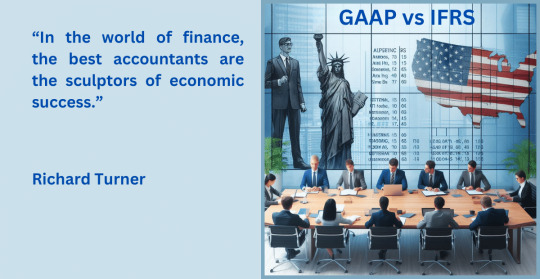
12. Ethical Considerations
12.1. Ethical Dimensions in Financial Reporting
a. Ethics in Financial Reporting Standards
Ethical considerations are integral to the formulation and adherence to financial reporting standards. The principles of integrity, objectivity, and transparency underpin ethical financial reporting. Standard-setters, regulators, and companies must navigate ethical dimensions to ensure that financial reporting serves the interests of investors and the broader public.
b. Upholding Integrity and Objectivity in Reporting
Upholding integrity and objectivity in reporting requires a commitment to ethical conduct. Companies must prioritize accurate representation over short-term gains, fostering a culture that values transparency. Regulators play a crucial role in setting the ethical tone, emphasizing the importance of unbiased and principled financial reporting in maintaining the integrity of capital markets.
12.2. Ethical Challenges for Accountants
a. Common Ethical Dilemmas in GAAP and IFRS
Accountants face common ethical dilemmas in navigating the intricacies of GAAP and IFRS. Issues such as revenue recognition, asset valuation, and disclosure requirements present challenges where ethical considerations intersect with professional responsibilities. Accountants must navigate these dilemmas with a commitment to ethical conduct, considering the broader impact on stakeholders and financial markets.
b. Navigating Ethical Challenges in Reporting Standards
Navigating ethical challenges in reporting standards involves equipping accountants with the tools and guidance needed for principled decision-making. Ongoing professional development, ethical training programs, and mentorship initiatives contribute to a culture of ethical awareness within the accounting profession. Companies, in turn, benefit from the assurance that financial reporting is not only compliant but also aligns with the highest ethical standards.
12.3. Regulatory Measures for Integrity
a. Regulatory Safeguards: Ensuring Ethical Conduct
Regulatory safeguards play a crucial role in ensuring ethical conduct in financial reporting. Regulatory bodies must establish and enforce ethical standards, conduct regular audits, and impose sanctions for non-compliance. A robust regulatory framework promotes integrity in financial reporting, reinforcing public trust in the accuracy and reliability of financial statements.
b. Maintaining the Integrity of Financial Reporting Standards
Maintaining the integrity of financial reporting standards requires a collaborative effort between regulators, standard-setters, and industry stakeholders. Periodic reviews, stakeholder consultations, and responsiveness to emerging ethical challenges contribute to the ongoing refinement of standards. The commitment to upholding ethical principles ensures that financial reporting continues to serve as a cornerstone of trust in the global business landscape.
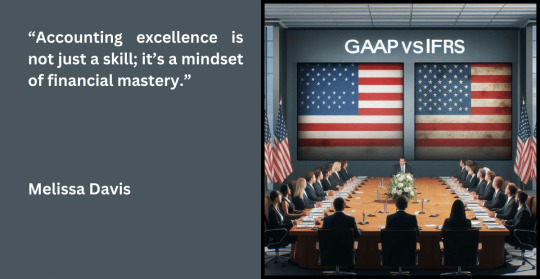
13. Future Trajectories
13.1. The Evolution of Reporting Standards
a. Anticipating Future Changes
Anticipating future changes in reporting standards involves considering the dynamic nature of global business, technological advancements, and shifts in investor expectations. Standard-setters must adopt a forward-looking approach, engaging in scenario planning and staying attuned to emerging trends. The ability to anticipate future changes ensures that reporting standards remain relevant and adaptive to the evolving needs of the business environment.
b. Technological Innovations and Reporting
Technological innovations are poised to shape the future trajectory of reporting standards. The integration of artificial intelligence, blockchain, and data analytics introduces opportunities for enhanced accuracy, efficiency, and transparency in financial reporting. Standard-setters and companies must embrace these innovations responsibly, balancing the benefits of technology with the imperative of maintaining ethical and transparent financial practices.
13.2. Convergence vs. Divergence
a. Assessing Convergence Prospects
The prospects of convergence between GAAP and IFRS continue to be a topic of consideration. While convergence offers the promise of a more standardized global approach, challenges such as differing legal frameworks and regulatory philosophies persist. Assessing convergence prospects involves a nuanced examination of global trends, regulatory developments, and ongoing efforts by standard-setters to bridge divergences.
b. Navigating Divergences in Global Standards
Navigating divergences in global standards requires a pragmatic approach that acknowledges the unique needs of individual jurisdictions. The coexistence of multiple standards necessitates effective communication, education, and cross-border collaboration. Standard-setters can play a pivotal role in facilitating harmonization efforts, fostering a global financial reporting landscape that balances convergence with the flexibility needed to accommodate diverse economic and regulatory environments.
13.3. Sustainable Reporting Paradigms
a. The Rise of Sustainable Reporting
The rise of sustainable reporting reflects a paradigm shift in the broader understanding of corporate performance. Investors, regulators, and the public increasingly recognize the importance of environmental, social, and governance (ESG) factors. Future reporting standards are likely to integrate sustainable reporting paradigms, providing a more comprehensive view of a company’s long-term value creation and societal impact.
b. Integrating ESG Metrics into Reporting Standards
Integrating ESG metrics into reporting standards requires a collaborative effort between standard-setters, regulators, and industry stakeholders. The development of clear guidelines, standardized metrics, and transparent disclosure requirements enhances the credibility of sustainable reporting. Companies embracing ESG considerations in their financial reporting contribute to a more informed and responsible investment landscape.

14. Conclusion
Financial reporting standards, whether grounded in GAAP or IFRS, serve as the bedrock of transparency, trust, and accountability in the global business landscape. The evolution of these standards reflects a journey of adaptation to changing business dynamics, regulatory landscapes, and investor expectations. While GAAP and IFRS diverge in certain philosophies and approaches, they share a common goal – to provide reliable and relevant information for decision-making.
As we navigate the complexities of GAAP vs. IFRS, it is imperative to recognize the strengths and limitations of each framework. GAAP, with its historical cost emphasis and rule-based approach, offers stability and comparability. In contrast, IFRS, operating under a principles-based approach, provides flexibility and a global perspective. Understanding the variances in revenue recognition, asset valuation, and consolidation methods is essential for investors, analysts, and companies alike.
Looking ahead, the trajectory of reporting standards involves a delicate balance – between convergence and divergence, between technological innovation and ethical considerations, and between traditional financial metrics and sustainable reporting paradigms. The future holds the promise of more standardized, adaptive, and responsible reporting standards that cater to the diverse needs of a dynamic global economy.
In conclusion, as the landscape of financial reporting continues to evolve, stakeholders must remain vigilant, adaptive, and collaborative. Whether one adheres to GAAP or IFRS, the shared commitment to integrity, transparency, and accountability ensures that financial reporting remains a cornerstone of trust in the interconnected world of business and finance.

#cfo#banking#accounting#finance#investment#personal finance#international finance assignment help service#financial management#financial markets#financial modeling#financial planning#financial dominance#financial services#financial literacy#financial drain#management#business#entrepreneur
0 notes
Text
DARKNESS OF DEVOTION

PAIRING: sunghoon x fem!reader
GENRE/CW: smut, dubcon, unprotected sex (wrap it before you tap it), blowjob, fingering, bondage, degradation, impact play, usage of nicknames, breeding, possessiveness, stalkerish behaviour, lmk if i missed anything.
SYNOPSIS: Never in a million years you could have imagined your polished and perfect boss to have handcuffs in his office, and well, stalker tendencies. You thought you were just an intern for him, but he simply saw you as possession.
WORD COUNT: 2.6k words
WARNING: 18+ content, minors dni
A/N: hihi, loves! i truly have never tried the concept of dubcon before, but this is for @hoondrop who loves possessive hoon and @evermorehoon who preaches head pusher hoon agenda ! i hope you guys will like it :3 all likes, comments, reblogs and feedbacks are highly appreciated! iloveyou all <33

You were just the new intern at the firm where Sunghoon worked, him being your boss. You directly answered to him as he checked your progress each day, only—you didn’t know how obsessed he’s been with you from the day one, monitoring your every move, to the point he installed a camera at your work desk to check if you’re not texting any other guy—you were, but, he needs you all to himself.
Then came the night where everyone left the office and he asked you to stay back and do the work he assigned you, ensuring that you’ll get a bonus if you actually end up doing a good job. Little did you know that he’d come out when the office lights would go dim, just him and you in the building, and the handcuffs he had gotten just for you.
He comes around, leaning against the back of your chair to look into the monitor, so close you could feel the scent of his cologne, his hand resting on your shoulder as he leans in further when he feels you shake under his gaze.
“So, who’s the guy you were texting earlier?” He asked, and you stilled completely, “you do know that it’s not allowed during work hours, right?” He whispered, grabbing your chin, “right?”
You nodded as if in a trance.
“Y—yeah, I’m sorry,” he only chuckled at your reply.
“You don’t need anyone when you have me,” he muttered darkly, not giving you a second before picking you up effortlessly as you screamed, taking you to his office room, “shh, don’t make it hard for the both of us, kitten. Be a sweet fucking girl for me, yeah?”
“What—” You asked, suddenly breathless at looking at the man with a sharp jawline, fangs peeking through his plush lips and eyes dark, sweet moles scattered across his face, and specs perched on his ever so perfect nose.
He kicked the door shut behind him with the heel of his shoe, the loud click of the lock sounding like a final verdict, just making sure that you knew what you had gotten yourself into. You squirmed in his arms, but he didn’t even flinch, holding you against his chest like you weighed nothing, that he needed you.
Sunghoon set you down gently on the plush leather couch in his office, fingers brushing against your thighs a little longer than necessary. His eyes roamed your body like he was trying to memorize every detail, every inch of you.
“Good girls don’t lie, y’know?” He said, removing his blazer agonizingly slow, to the point you couldn’t help but stare at his physique, “and they don’t flirt with others when they know someone’s watching, yeah?”
“I wasn’t flirting,” you whispered, legs pressing together instinctively, rubbing against each other. “Oh, yeah?” He cocked his head, unbuttoning his cuffs, “then why did I see you giggling at your phone like a fucking whore in heat?”
Your breath caught, heat rising to your cheeks at the blatant degradation, “that’s not fair—”
“What’s not fair,” he interrupted, his figure looming over you, “is how much I’ve done to keep you here. You think I didn’t notice the way you smiled at that guy from finance? The way you smile as if he means something to you?”
You tried to look away, but he gripped your chin, forcing your eyes back on him, his voice dropped an octave lower, almost like velvet but with a hint of poison.
“I’ve been patient, kitten. So fucking patient, but tonight—tonight you’re going to learn who you belong to, okay?”
A glint of silver shining caught your eye—he had pulled the handcuffs from his drawer, dangling them by one finger with a smirk.
Your heart thudded violently in your ribcage, so fast that you feared it would break, “what? No! You can’t just—”
“I can,” he cut you off, “and I will. You can say no, kitten, I won’t stop you. But I don’t think you will. You want this, don’t you?”
You couldn’t speak, you couldn’t say no, your voice failing you, and he had you right where he needed you to be. Your body betraying you, every shiver, every tremble catching his eyes, and lord he thrived on it.
“You’re so scared, aren’t you?” He murmured, crouching down between your knees, his big, slender fingers gripping your thighs, “but—god baby, you’re so excited too, I can feel it. You’re already wet, aren’t you?”
You hated how right he was, hated that your pulse raced when he touched you, the wrongness of the whole situation just made it worse.
Sunghoon leaned in, lips brushing your ear, “tell me to stop. One word, and I walk away.” He challenged.
Followed by your silence, just the sound of your deep breaths filling up the room. You didn’t say it, you couldn’t.
“Yeah? Good fucking girl.” His voice was thick, as if he had won already (he did), and before you could say say anything else, his hand tangled into your hair, rough, no more teasing—and he yanked your head back until your breath hitched and your lips parted with a soft, involuntary gasp.
“On your knees, now.”
It was a request, but an order, and he chuckled at how your legs buckled, your makeup smudged already, blouse clinging onto your damp skin. He wasn’t pretending to be your boss anymore, the evil glint in his eyes no longer hidden by any means. He was something else now, an obsessive, unrelenting man.
“Don’t,” you breathed out, “Sunghoon, please. I—didn’t mean—”
“Didn’t mean to be a fucking tease?” He snapped, catching your wrist with a hand and shoving you back against the nearest wall, the frames on the wall rattling with the impact, “didn’t mean to smile at him? I have been the one taking care of you, kitten.”
“You’re fucking hurting me,” you snapped, voice trembling with fear but also fury.
But Sunghoon only grinned like a maniac, “good,” he said, eyes flicking down to your wrists, where he held you firmly, bringing them to the back so he could handcuff you hard enough to dig into your skin, “pain means you’re still pretending.”
Your body jerked, trying to push him off with your shoulder, but his reflexes were too fast, he shoved you back again, harder this time, your hands useless behind you.
“Let me go, you’re so fucking sick,” you glared at him now.
He leaned in close, nose brushing against yours, his breath hot, “you think I’m the sick one baby?” His fingers brushed between your thighs and right up your skirt, caressing your panties, “then why the fuck are you this wet?”
You let out a gasp, trying to move again but he held your waist to keep you in spot, the other hand now gripping your jaw so tight it ached.
“You think I can’t see what you’re doing? Acting like a fucking brat now that you have my attention, huh? Pushing me back like you don’t want me,” his lips brushed your ear, voice almost a growl now, “but your body, yeah fuck, your body loves this so much, you need to be out in your place.”
“You’re disgusting.”
“And you’re dripping for me.”
He spun you around, forcing you to bend over his desk, cheek pressed against the cold wood. He shoved up your skirt as you tried to kick backwards, but he only chuckled, catching your ankle mid kick to spread your legs wider.
“Keep fighting,” he murmured, dragging his fingers up your soaked panties, “it makes me want to ruin you more.”
You cried under him, chest pressed to the desk and fists clenching, “you’ll regret this,” you said.
“No,” he whispered.
You barely had time to process anything before Sunghoon’s hand tangled in your hair again, taking your head back and bending your body, his breath against your neck.
“There’s no room for regret here, we’re just getting started, baby.” He moved with control, dragging two fingers against the soiled cloth, “still wet? How fucking cute.”
Then his palm landed on your ass harshly, once, then again, until you were gasping and thrashing around.
“That’s for flirting with the finance asshole,” he groaned, “then this, for not wearing that white blouse I love so much,” he mumbled, as if you had any clue about his favourites.
Your legs almost gave out as you tried to get out of his hold but it was hopeless, you were cuffed, bent over, and now his palm was making your ass—and he was just getting started. You choked on a sob, the humiliation seeping through as he pulled your panties down with a rough pull, the cold air caressing your skin, his groan vibrating against your back.
“Fuck, so filthy, your body isn’t even denying it anymore.”
He stepped back for a moment, and you breathed hard when you heard the sound of a belt unbuckling, slow.
“Sunghoon—” your voice cracked.
“Shut the fuck up,” he snapped, and you felt something hard smacking against your thigh—his belt. “You lost the right to talk when you whimpered for me the second I touched you.”
You sobbed again, moaning alongside with how wrong it felt to actually like something as twisted as this, you couldn’t even admit it out loud, you simply couldn’t.
You jolted again, a cry escaping before you could stop it, your legs gave out, wrists still bound behind you, cheeks hot with a mix of fear, shame, and something far worse—arousal that you couldn’t explain to anyone, not even yourself.
Sunghoon stepped in front of you, keeping his belt on the desk, unzipping his slacks like he had all the time in the world.
“Open your mouth,” he ordered.
You shook your head slowly, “n—no,” you cried.
That was a wrong move.
He grabbed a fistful of your hair and yanked hard—forcing your head back until you cried out, your neck exposed, your lips parted just from the force of his grip.
“You’re really testing me tonight,” he growled, stepping closer until the head of his cock pressed against your lips, “you wanna make this harder for yourself? Fine. You’ll choke on it.”
He didn’t wait, he shoved himself into your mouth with one hard thrust, the taste of him flooding your tongue as your gag reflex immediately kicked in. You choked, whimpering around him, but he held your head steady with both hands now, thrusting into your throat like he didn’t give a damn, pushing your head deeper with a low groan.
“That’s it,” he hissed, hips snapping forward, “take it, take it like a good fucking whore.”
Your eyes watered, drool spilling from the corners of your mouth as he used you without pause, his grip in your hair was bruising, keeping you exactly where he wanted you—his personal fuckhole, gagging on his cock in the same office where you’d tried to act professional just hours ago.
“This mouth doesn’t deserve to speak unless it’s wrapped around me,” he said, thrusting deep again. You gagged loud this time, trying to pull back, but he shoved you right back down.
“You hear that?” he growled, staring down at you, your lips red and stretched, your eyes wide and teary, “that’s the sound of you learning your place.”
He held himself there, cock resting deep in your throat while your body jerked, struggling for breath, your cuffed hands useless behind you. Just when your vision blurred from lack of air, he pulled out with a wet pop, strings of spit and pre cum connecting your swollen lips to his length.
You collapsed forward, coughing, drooling, body trembling—completely wrecked, but still wet, still breathing hard, and now looking up at him in a different light, and you gulped harshly in fear now that you knew you liked it, ashamed of yourself for thinking so.
“Aw,” Sunghoon mocked you, “already broken, kitten. You’re my doll, aren’t you?” He asked, petting you like a dog.
You didn’t even flinch at the touch, only looking at him as you took in deep breaths. He tilted his head, watching you with that same hungry intensity you’d seen behind his glasses in the office all along—only now, the mask was gone. He didn’t have to pretend anymore.
“You liked that,” he said quietly, almost in awe, like he was marveling at the mess he made, “and you’re still fucking dripping.”
“Please—”
“Shh, open,” he parted your lips with his thumb, going down to collect your wetness, and he pushed his soaked fingers into your mouth. You gagged, humiliated, as the taste coated your tongue with embarrassment.
“Good girl,” he murmured, thumb brushing your cheek in twisted praise as you struggled, “see? I knew you’d learn for me, just for me, hm?”
He stood again, towering over you, then pulled your handcuffs—forcing your upper body upright. You cried out, the strain on your arms sharp, your blouse now torn and half hanging off your shoulder.
You didn’t respond, you couldn’t. Your lips were parted, chest heaving, eyes wide and dazed as he spun you around to face him. Still cuffed, still naked from the waist down, legs trembling.
He gripped your chin and forced your eyes up to his. “Say it,” he whispered. “Say you liked it.”
You shook your head weakly, shame crawling up your spine. “I—I didn’t—”
He scoffed, eyes darkening, “I said,” he muttered, “say. You. Liked. It.”
You tried to speak, but you couldn’t. You tried to turn away, but his grip on you tightened.
“I—I liked—”
“Look at your cunt,” he dragged two fingers back between your thighs and shoved them in without warning, “still wet and clenching. Still desperate. You’re not even pretending anymore.”
You cried and he only smiled, finally kissing your lips, tasting himself on your tongue, tasting the tears that stained your face, and swallowing your moans. Sunghoon found this romantic, as if it was all he had ever wanted.
“Don’t cry now, kitten. You’re not sorry, you’re ashamed because you liked it. Because you wanted it, because you want more.”
“I hate you,” you whimpered, breath hitching as your thighs trembled again.
“Yeah? But I fucking love you,” he mumbled, sick and twisted as your body gave into him, moaning his name like a desperate slut.
That’s when he pushed you against the desk, giving you no warning before thrusting into your leaking little hole. You screamed and he laughed.
“Say my name, go on.”
“Sunghoon—fuck please—Sunghoon,” you moaned.
“That’s it,” he hissed, one hand gripping your hip, the other sliding into your hair, “my good, dumb little slut, all fucking mine, you’re mine, mine.”
He fucked you rough, it was deep, fast, and filthy. The mirror shook on the table shook and you cried out, drool slipping past your lips, every thrust breaking you down further.
“This is all you’re good for,” he growled, pounding into you so hard the glass fogged with your breath, “getting ruined by the man who fucking owns you, yeah?”
You came fast, embarrassingly fast, cunt clenching around him with no resistance, no fight, just pure ecstasy and embarrassment.
But he didn’t stop.
“Fuck,” he groaned, hips snapping, “you’re so fucking perfect like this. Look at you—my favorite toy, crying and creaming all over my cock like you’re meant to do this, to be my fucking doll.”
He took your moans in, kissing you again, and again, till he couldn’t breathe anymore.
“You were made for this.”
And then he filled you again, his hand on your jaw, forcing your face to the mirror, “Look at yourself,” he panted, cock twitching inside you, “look how pretty you are when you break, when you submit to me, when you let me breed that pretty cunt of yours.”
“Sunghoon—” you mumbled against his lips.
“Yeah? You’ll look so good all swollen for me, for me, yeah?”
You nodded weakly, making him smile, “you’re fucking mine, do what I say now, hm?”
And you did exactly what he asked for—for you to be his.
Only his.

THANK YOU FOR READING!
@jaeminvore @macaroonff @ajayke-reads @en-myworld @lunalovesstories @jayzdaze @deobitifull @celeste-hoon @mari-oclock @kpoprhia @ikeuizm @woniebae @lalalalawon @blessedcursd @skzenhalove @heesuncore @seuomo @kyurizeu @haechan-nahceah @tobiosbbyghorl @jezzebear @jaehoonii @itsgivingitalian @bunhoons @hyacandoit @luvswonyoung @ma-riiii @addictedtohobi @heeliopheelia @haanigurl @dopedels @kaykay11sworld @glitterjay @skzooluvr @yongbokified
taglist open! send an ask or comment to be added!

© jaylaxies | tumblr
#fic : darkness of devotion#enhypen hard hours#enhypen smut#sunghoon smut#kpop smut#enha smut#sunghoon x reader#enhypen imagines#enhypen x reader#enhypen x you#enhypen
2K notes
·
View notes
Text
International Finance Mastery: The Key Role of Assignment Help in Student Success

In the dynamic realm of academic pursuits, mastering international finance is a critical milestone for students aspiring to navigate the complexities of global economies. As students delve into the intricate world of international finance, they often find themselves grappling with challenging assignments that demand a deep understanding of diverse financial concepts. This is where the invaluable support of international finance assignment writing help comes into play. In this blog, we will explore the significance of assignment assistance in enhancing student success in the field of international finance.
Understanding the Challenges:
International finance is a multifaceted discipline that encompasses a wide array of topics, including exchange rates, foreign direct investment, global financial markets, and risk management. The complexity of these subjects often leaves students feeling overwhelmed and in need of guidance. Assignments in international finance require students to apply theoretical concepts to real-world scenarios, analyze data, and draw meaningful conclusions. This can be a daunting task, especially for those still grasping the fundamentals of the subject.
The Role of International Finance Assignment Writing Help:
Conceptual Clarity: International finance assignment help services play a pivotal role in providing students with conceptual clarity. Professional writers with expertise in international finance can break down complex theories and explain them in a manner that is easy for students to comprehend. This not only aids in completing assignments successfully but also contributes to a deeper understanding of the subject matter.
Timely Submission: The academic journey is often characterized by tight deadlines and competing priorities. Assignment help services offer a lifeline to students by ensuring timely submission of assignments. Meeting deadlines is crucial for academic success, and expert assistance can alleviate the stress associated with last-minute rushes, allowing students to focus on learning rather than time constraints.
Customized Solutions: Every assignment is unique, and international finance assignments are no exception. Assignment help services provide customized solutions tailored to the specific requirements of each task. This ensures that students receive content that is not only accurate but also relevant to the assignment's objectives, enhancing the overall quality of their submissions.
Enhanced Research Skills: Assignments in international finance often require extensive research and data analysis. Seeking assistance from professionals in the field can serve as a learning opportunity for students, helping them develop their research skills. By reviewing well-crafted assignments, students can gain insights into effective research methodologies and apply them to their future academic endeavors.
Graded Excellence: The ultimate goal of any student is to achieve academic excellence. International finance assignment writing help services are equipped to deliver assignments that meet the highest academic standards. As a result, students stand a better chance of securing top grades, boosting their overall academic performance and opening doors to future opportunities.
Mentorship and Guidance: Beyond the completion of assignments, seeking help from professionals provides students with valuable mentorship and guidance. Experienced writers can offer insights into the practical applications of international finance concepts, preparing students for challenges they may encounter in the real-world scenarios of the global financial landscape.
Conclusion:
In the intricate landscape of international finance, assignment help services serve as a beacon of support for students navigating the challenges of this dynamic field. From conceptual clarity to timely submission and mentorship, the benefits of seeking international finance assignment writing help are manifold. As students aspire to master the complexities of global finance, they can leverage these services to not only excel academically but also gain valuable insights that will shape their future success in the international financial arena. Embracing this assistance is not a sign of weakness but a strategic move towards a brighter and more informed academic journey.
#Online international finance Assignment Help#international finance assignment help service#international finance assignment help online#international finance assignment help usa#international finance assignment help australia
0 notes
Text
International Relations Assignment Help
International Relations Assignment Help is a specialized service aimed at assisting students in understanding and excelling in the complex field of international relations. This academic support offers comprehensive guidance on various topics, including diplomatic history, global politics, international law, and foreign policy analysis.

#International Relations Assignment Help#childcare assignment help#accounting assignment help#management assignment help#finance assignment help#assignment help#online exam help#cdr report writing help#economics assignment help#xero assignment help
0 notes
Note
so glad you're back doing requests!! ilysm hope you're all good now!! 🥺🥺
on that note, there's been a serious lack of haganezuka content in general and I'm appalled by this man's underratedness
can I request for haganezuka and an arranged marriage s/o? like the chief set them up and haganezuka is like dammit why tf do I gotta marry a rando but then slowly falls for his partner
tsundere to simp haganezuka is the best i will die on this hill
Aaah! I have only done one for Haganezuka so I’ll do it again. He is big Tsundere and he’ll keep being a Tsundere! Thank you dearly for such a creative and original concept! Have a wonderful day, darling!
Hotaru Haganezuka- Nothing or Everything

In the moment, Hotaru was so annoyed and so uninterested that he could barely look at his Chief in the eyes as he announced the arranged marriage to be official. Married off to some stranger for further finance and protection to the Swordsmith Village. This village is the most closed-off, hidden thing in Japan, why does it need more security?!
Hotaru just grimed and bared through the painful vows that meant nothing to him and had to deal with the fact his supposed spouse is now coming home with him
Hotaru, right off the bat, established to you that you’re not sleeping in the same bedroom as him, you’re not touching any of his belongings and you mean little to him. That this marriage means nothing to him but it’s more of a requirement he is forced to follow. He is the most prickly, unapproachable swordsmith in this entire population, there is no way to get him to like you… so, he suspected this would be the end of it. He’d ignore his legally-assigned spouse and continue on with his beloved work
But… clearly. Fate has decided that Hotaru isn’t going to be alone anymore
Throughout the months after the wedding and you moving into his home, Hotaru had been quiet, harsh, uncaring, uninterested and ignoring you in favour of doting his time, energy and passion into the one thing he loves; swordmaking. However, he has begin to notice you more. The way you make him lunch, the way you patch up his wound after fighting stubbornly with him, the way you clean his home, respect his privacy, give him space… maybe you’re not that bad
Hotaru is a man of pure, raw pride so he simply refused to admit the fact he was slowly but surely falling in love with you, his arranged spouse. He couldn’t admit the fact you made his heart jump up and down, and his head spin. The fact everything you do for him is no longer thought as annoying or sucking up to him but is appreciated internally and acknowledged
Of course, Hotaru will just keep up his now fake disliking and tsundere nature since he’s too closed off and of his own ego to let you know you’ve won him over and now, he likes to admire you from behind his mask. You’re so pretty, so considerate, so ambitious and determined. He loves those type of traits in people, the good ones with an iron will and sly sharp senses. He likes the way you run and he does appreciate it when you actually take time out of your day to deal with him
Hotaru, over more and more time spent with you. Almost a year now, can’t help but soften up. Go from ignoring and snarling to looking right at you and nodding. Acknowledging and listening. Everybody in the village thought it was completely impossible to ring out anything kind and positive from Haganezuka himself but here he is, actually simping for you behind your back
Writing your name in his swordsmithing tools, seeing your reflection through the water cooled shiny silver-like metal of a freshly formed Nichirin Katana, hearing your voice when he is walking back from his swordsmithing hut to his cottage. You corrupt his head 24/7 and he is inbetween being annoyed over it and loving it. To think, he couldn’t stand the fact you were even breathing in the air of his home, now, he wants you around him all the time but he is too protective to let you be around dangerous equipment like his own
Hotaru is getting there over time. He is coming to you and even offering you little gifts whilst looking away and gruffing up. Immediately proclaiming, with image-saving formed anger, that what he has done for you has nothing to do with his own feelings and is just a requirement to make you happy for the Village’s sake. He’s right… gift-giving and love-giving is a requirement, but a requirement his own heart is pushing him to do. Because he’s in love and enamoured with you as a whole
Now. Hotaru wants you to come to his bedroom, act more like your husband and he’s trying to fulfil all those duties he should have when he was wedded to you, how could he be so foolish and blind to the fact you’re perfect? He is quite emotionless, harsh and work-obsessed but he is much more doting and caring than he looks and behaves as
“H-Hey… dummy, can you read that novel outloud? I haven’t read it before and since you’re reading it, why not just read it outloud for both of us so— O-oh, shut up! I don’t like you!”
#kimetsu no yaiba#demon slayer#anime and manga#kny imagines#short story#romantic short story#cute short story#kny characters#haganezuka hotaru#hotaru haganezuka#kimetsu hotaru#kny hotaru#demon slayer hotaru#kimetsu no yaiba hotaru#haganezuka fluff#kimetsu haganezuka#kimetsu no yaiba haganezuka#demon slayer haganezuka#haganezuka x reader#kny haganezuka#arranged marriage au#tsundere#he just a tsundere#best kny boy#kny x reader#hotaru haganezuka x reader
661 notes
·
View notes
Text

Learn 8 effective strategies for hedging foreign exchange risks. Engage with our international finance assignment help experts for A grade solutions & top grades.
0 notes
Text
Jedi Order Bureaucratic Structure
I’ve been working for a while on worldbuilding the inner workings of the Jedi Order. Below is a flowchart of the administrative bodies, their duties, and any other admin bodies they oversee. More details on each below the cut.
These are different groups involved in running the Jedi Order. For different roles within the Jedi, see my Jedi Order Corps and Subdivisions.

High Council: (Finance, bylaws, PR, major trials)
Determines the budget(s)
Relations with the Senate
Only body that can expel members
Librarian's Assembly: (Ensures knowledge is available to Jedi)
Fund academic researchers (many Jedi researchers work directly for the assembly)
Archives: (Run the Archives & research)
Host academic conferences
Protect important artifacts
Run basically directly by the Librarian's Assembly
Department of Classes: (Adult education)
Organize all classes that aren't geneds
Set criteria for certifications/ degrees
Help members get degrees from external organizations
Council of Reassignment: (Oversees transfers & is Jedi CPS)
New Initiate paperwork
Transfers between corps and/or branches
Helps members leave the Order
Checks the CoFK when necessary
Padawanship paperwork filed here (crèchemasters sign off, padawan signs off, check master for red flags/ not allowed to take apprentice, sometimes mind healer signs off)
Council of Justice: (Attourneys & internal justice system)
Try & punish cases committed by Jedi & internal to the Jedi Order
Mediate interpersonal disputes
Lawyers for the Order
Cannot expel members
Council of Outreach: (Manages outposts & patrols)
Assigns Jedi to satellite locations or watchfolk posts
Hires other outpost staff
Ships supplies to & from outposts
Tracks the locations of missions & sends Vanguards to areas that haven't been visited recently
Council of Temple Maintenance: (Oversees internal services and temple upkeep)
In charge of the cleaning droids
Coordinates trash & recycling with Coruscant government
Has the occasional member who can do specialized maintenance (ex. plumber, electrician)
Volunteers sign up to fix things
Hires outside contractors when there isn't a Jedi with the necessary skills
Assigns Jedi to living quarters
Interior decor
Delegates chores such as taking out the trash, mopping, dusting, etc.
Padawans and initiates are often assigned these chores as punishments
Kitchenmasters: (Mess halls)
Make & serve food in the mess halls
Label the food with which species can eat it
Order food supplies
Supervise initiate clans helping in the kitchens
Quartermasters: (Distribute supplies & manage finances)
Bulk-order supplies for the Order
Provide mission allotments
Desk operators help members pick up supplies
Accounting
Transport Office: (Run the hangar bay & speeder pool)
Responsible for the Order's vehicles
Mechanics
Vehicles are checked in & out like a library for cars & ships
Hire external staff when there aren't enough Jedi
Temple Guard: (Security & emergency response)
Guard against exterior threats to the temple
Security during criminal situations
Really good at sensing danger to temple inhabitants
First responders (fire & police-- MedCorp handles EMS)
Change lightbulbs and smoke detector batteries
Odd jobs on behalf of the CoTM
Uses the lore by Adsecula in "Nameless"
Council of Reconciliation: (Central hub of Jedi outreach & diplomacy)
All aid requests go through them
Sets mission objectives
Approve or deny aid/ mission requests
Reviews behavior of Jedi on missions when there are issues
Mission Consignment: (Assign Jedi to approved missions)
Desk jockeys
Not officially divided by type of mission/ Jedi role needed, but missions will be passed to people who are more familiar with the experts required
Organizes specifics for missions such as transportation and housing
Council of First Knowledge: (Runs Initiate & Padawan dorms, clans, & childhood education)
Initiate clans members live together with their crèchemasters rotating out night shifts
Padawans & Senior Initiates live in individual rooms in designated halls with some crèchemasters living in each hall
Department of Seekers: (Regulates conduct of Seekers)
Create regulates for what Seekers can & cannot do & how they should act
Investigate reported misconduct by Seekers
Crèche: (Organizes care for Initiates)
Sort Initiates into clans
Run events/ field trips/ etc.
Set educational standards
see my post about Living Quarters in the Jedi Temple
Department of Primary Classes: (Classroom education for younglings)
Standard elementary school operation stuff
Provides the general education classes all Jedi take as younglings
Circle of Healers: (Sets certification requirements)
Certified to train medical professionals for a variety of degrees
Determines when Jedi have fulfilled requirements for medical certifications
Sets the qualifications for Force-specific medical degrees
Halls of Healing: (Healthcare within the Order & internal outreach)
Like a local hospital but also has general practitioners
IRB: (Reviews research for ethical concerns)
Institutional Review Board
"Under FDA regulations, an Institutional Review Board is group that has been formally designated to review and monitor biomedical research involving human subjects. In accordance with FDA regulations, an IRB has the authority to approve, require modifications in (to secure approval), or disapprove research. This group review serves an important role in the protection of the rights and welfare of human research subjects."
IRB for the entire Order, not just the MedCorps
#dorphin's jedi lore#gffa worldbuilding#jedi worldbuilding#star wars worldbuilding#lore#mine#jedi#jedi order#pro jedi
76 notes
·
View notes
Text







Sebastião Ribeiro Salgado Júnior
(February 8, 1944 – May 23, 2025)
Mr Salgado was the only son of a cattle rancher who wanted him to become a lawyer. Instead, he studied economics at São Paulo University, earning a master's degree in 1968. While working as an economist for the Ministry of Finance (1968–69), he joined the popular movement against Brazil's military government.
Seen as a political radical, Salgado was exiled in August 1969. He and his wife fled to France, where he continued his studies at the University of Paris. In 1971, while on an assignment in Rwanda as an economist for the International Coffee Organization, he took his first photographs and soon decided to teach himself the craft. He became a freelance photojournalist in 1973.
Over the next decade Mr Salgado photographed a wide variety of subjects, including the famine in Niger and the civil war in Mozambique.
He won the City of Paris/Kodak Award for his first photographic book, Other Americas (1986), which recorded the everyday lives of Latin American peasants. This was followed by Sahel: Man in Distress (1986), a book on the 1984–85 famine in the Sahel region of Africa.
In the 1990s Mr Salgado recorded the displacement of people in more than 35 countries, and his photographs from this period were collected in Migrations: Humanity in Transition (2000). Many of his African photographs were gathered in Africa (2007). Genesis (2013) assembled the results of an eight-year global survey of wildlife, landscape, and human cultures uncorrupted by the onslaught of modernity and industrialization. Other publications included Kuwait: A Desert on Fire (2016), Gold (2019), and Amazônia (2021).
In 1998 Mr Salgado and his wife, Lélia Wanick Salgado, helped to found the Instituto Terra, a project that endeavoured to restore a degraded portion of rainforest in Minas Gerais, Brazil.
He was the subject of Wim Wenders's documentary The Salt of the Earth (2015).
Rest In Power !
#human rights#art#humanity#equal rights#freedom#photography#peace#women's rights#democracynow#dictatorship#brazil#rip#rip salgado#rainforest#wim wenders#social justice#political#mozambique#famine#migration#war#civil war#niger#africa#genesis#sustainability#sebastiao salgado#instituto tera#legend#icon
15 notes
·
View notes
Text
ACADEMIC LIABILITY or ACADEMIC WEAPON?! — one piece in college

sanji is a hospitality major -> very obvious -> eventually wants to go to culinary school and open his own restaurant, but wants to get some work experience in and wouldn't mind working in a hotel for a year or two -> rooms with zoro; they both got randomly assigned based off signup sheets and they've been torturing the housing incharges to change ever since then -> the housing dept is so fed up with them that they're not budging just to spite them -> zoro regularly buys the wrong kinds of ingredients for him and sometimes messes with his schedules so he's late for classes -> did a semester abroad in france and is planning to do one in italy to intern under his favourite chefs -> watches and falls asleep to reruns of the great british bake off or masterchef jr. -> is a pleasure to generally have in class and submits his assignments on time except when there are any sorts of accounting/finance courses he needs to take ... pesters nami to help with those -> probably tied with chopper and robin as the people who're the most genuinely passionate about their major -> hosts sunday study sessions where everyone comes to his dorm and studies while he cooks lunch for them -> makes nami, vivi and robin bentos the days they have long classes and drops them off at their buildings -> will make people on his floor food if they ask for it -> actually not that big of a fan of huge parties but gets dragged along by luffy anyways -> 100% academic weapon
zoro is a kinesiology major -> him and ace are prolific nappers. will nap anywhere: under a tree in the quad, in the library, in classes, etc. -> that is, if zoro actually makes it to his classes in the first place, he's so directionally challenged -> took him months to figure out the campus layout, will still end up 10-15 minutes late cos he took the wrong staircase up -> mainly just spends his time sleeping in the dorm or at the gym -> very intimidating in the gym, loads of people mistake him for a varsity athlete cos he'll casually be bench pressing mad numbers -> will spot your weights and help you out if you ask tho <3 -> sanji gets back at him by playing ridiculously loud music while cooking and giving him the wrong directions -> he still has to admit that for what it's worth he keeps sanji around since he's practically memorised zoro's meal preferences and macros (sanji will sneak in some greens and sugar here and there) -> does not party often but when he does he goes beast mode, drunk zoro blushes like crazyyy -> he's a girlfailure academically though, does not keep track of his assignments, all his coursework leaves his head the minute he leaves the classroom -> gets law or chopper to help him with basic biology parts of his major -> at one point paid chopper to do his assignments but chopper was too nice and did them for free until law found out and started going on about "child labour" or something -> he's BARELY making the passing grade -> 100% academic liability nami is a business major -> IT girl!! on top of everything always -> dorms with robin, is literally living the pinterest girl aesthetic -> super organised, notes are color coded, always running around campus with her cup of coffee -> is the president of the campus's women in finance club -> summer internships, TA-ing, you name it she's doing it -> is debating going down the investment banker route because of the 6 figure salary or starting her own business -> invented office siren core. she walks into a class with pointed kitten heels bayonetta glasses and everyone loses their shit -> at the same time is a party MONSTER -> her tolerance is unlimited . got a matching tattoo with vivi and robin one night -> she ran an alcohol supplying racket in her freshman year for a quick buck but switched to more legitimate moneymaking methods in her sophmore year, she now connects students from her highschool with college mentors -> her profs love herrr she hates being called a nerd but she pre-reads all her syllabus, is ready with good questions but she's not a nerd guys!! -> is the campus cafe's best customer. will stop by at least twice a day for some sugar/coffee shot that keeps her sane -> her and robin have a wine night every week where they watch real housewives, do skincare, and catch up on each other's lives -> robin lowkey worries for her because she's very ambitious but she trusts that vivi keeps nami sane when she's not around
robin is an archaeology and history double major -> why is she even in college (is a question her professors keep asking her) -> she could teach the class! (she's assistant in every department she's taken) -> definitely taking the academia route after college, also because she's genuinely passionate about teaching -> is overqualified to even sit in introductory level courses -> has been published as an undergraduate in multiple prestigious journals for papers that she wrote because she was "just curious" -> is a part of student government -> is also a part of the campus debate union, but is not as proactive as other members (eg. luffy) -> double majoring is a breeze for her. her assignments make her professors question their ability to grade -> singlehandedly carries the class average on her back -> is idolised by underclassmen because she's very sweet and patient -> got invited to join a lot of secret societies and sororities during her freshman year but politely declined -> could honestly be successful in any major since she has a general academic knack -> wants to take a year off after college to gain on-site archaeological experience in egypt -> is the mother of the group; everyone comes to her for advice whenever they're struggling to pick classes or feeling down -> her guilty pleasure is a good matcha latte. has bought a full matcha station to perfect her own lattemaking skills -> nami took her thrifting once and now she spends hours on her weekend in shops -> doesn't like partying so is often the designated sober one along with sanji and law, will occasionally smoke with him depending on how tolerable he is -> 100% an academic weapon

a/n: i'm a big yapper so ima do ace luffy chopper and law in the pt 2 for this ⁽ଘ( ˊᵕˋ )ଓ⁾
#one piece#one piece headcanons#one piece scenarios#one piece fluff#straw hat pirates#straw hat crew#nami one piece#zoro#roronoa zoro#cat burglar nami#nico robin#sanji fluff#vinsmoke sanji#black leg sanji#one piece x reader#[ tracklisted ]#sobsobs sorry about no readmore my post editor isn't working :(
58 notes
·
View notes
Text
Winx College AU
Can I be annoying for a sec? A College Winx AU came to me in a dream, so now I’m legally obligated to yap about it on tumblr dot com.
Disclaimer: This is based on absolutely nothing from the original lore. If you’re wondering why a certain character has a certain major, it’s because the voices told me so (okay, fine—I did try to make it make a little sense).
18-year-old Bloom, an international student from Italy, gets accepted to a university in Massachusetts on a full-ride scholarship. The school is big, castle-like, and ancient-looking. There, despite her true enemies—introversion and awkwardness—she finds her place among the student body.
Bios for the Winx girls:
Bloom: A freshman, an international student from the boonies southwest of Milan. Shy, awkward, but kind and hardworking. She lives on campus and shares a suite with Flora, Musa, and Tecna. Majors in Graphic Design (it would’ve been Fine Arts, but her parents wanted her to pick something that could land her a job). The type who has to work twice as hard to get a mediocre grade—her weekly study time easily hits 40+ hours just to maintain a good GPA.
Stella: A junior, originally from California. A popular sorority girl, she was assigned to be Bloom’s onboarding buddy. Majors in Communications—she switched from Finance midway through her sophomore year to keep up her sorority’s 3.0 GPA requirement. Stella’s not too concerned about her major anyway; her dad plans to hand her a branch of his company when she graduates. She just needed something that wouldn’t interfere with her free time or social life.
Flora: A freshman, originally from somewhere on the West Coast and Bloom’s roommate. Timid but down for anything. She’s the type to have a private Instagram with just 100 or so followers—even though she’s gorgeous enough (and wealthy enough, thanks to generational money) to be an influencer. Majors in general Biology to keep her options open, but plans to add a more specialized minor later on based on what she’s passionate about.
Musa: A freshman, local to the college area but originally immigrated with her dad from China when she was too young to remember. An extrovert to her core—but God help you if you interrupt her while she’s practicing. Majors in Classical Performance. Shares a room with Tecna. She’s low-key popular on social media for posting videos of herself playing various instruments.
Tecna: A freshman by age, but a sophomore on paper due to already taking upper-level classes. She’s from New York City and double majors in Computer Science and Math. An introvert by choice, but capable of talking to anyone. Everything comes easily to her when she puts her mind to it, and people are often jealous of how effortlessly she seems to do... well, everything.
Layla: A sophomore, local to the area. Part of the Dance Team, so her social circle is mostly athletes and cheerleaders. A Marine Biology major—beauty and brains. She’s been scouted for modeling countless times but couldn’t care less.
I like this! Is there a fic? Wow I’m so glad you asked! There is, actually: read Refer to Syllabus on AO3
13 notes
·
View notes